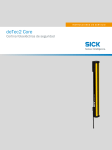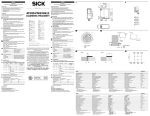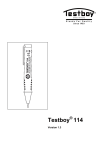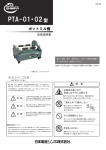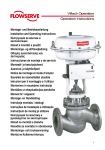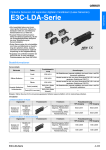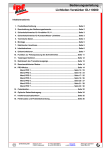Download MultiPulse - WTB4-3P2100S13
Transcript
8018539 OPERATING INSTRUCTION MultiPulse - WTB4-3P2100S13 Cylindrical photoelectric sensors en / de / fr / it / pt / es / zh / ja / ru SICK AG, Erwin-Sick-Strasse 1, D-79183 Waldkirch Photoelectric proximity sensor Operating instructions 1 Safety notes ■ ■ ■ ■ ■ ■ 2 Read the operating instructions before commissioning. Connection, mounting, and setting may only be performed by trained specialists. Not a safety component in accordance with the EU Machinery Directive. UL: Only for use in applications in accordance with NFPA 79. These devices shall be protected by a 1 A fuse suitable for 30 V DC. Adapters listed by UL with connec‐ tion cables are available. Enclosure type 1 When commissioning, protect the device from moisture and contamination. These operating instructions contain information required during the life cycle of the sensor. Correct use The MultiPulse WTB4-3 is an opto-electronic photoelectric proximity sensor (referred to as "sensor" in the following) for the optical, non-contact detection of objects. If the pro‐ duct is used for any other purpose or modified in any way, any warranty claim against SICK AG shall become void. Photoelectric proximity sensor with background suppression. Image: A 3 Commissioning 1 2 Mount the sensor using a suitable mounting bracket (see the SICK range of acces‐ sories). Note the sensor's maximum permissible tightening torque of 0.8 Nm. The sensors must be connected in a voltage-free state (Uv = 0 V). The information in the graphics [B] must be observed, depending on the connection type: – 8018539 | SICK Subject to change without notice Male connector connection: pin assignment 1 4 brn 1 blu 3 blk 4 + (L+) - (M) Q Image: B 3 Only apply voltage/switch on the power supply (Uv > 0 V) once all electrical connec‐ tions have been established. The green LED indicator lights up on the sensor. Explanations of the connection diagram (Graphic B): MultiPulse WTB4-3P (PNP: load -> M) Output oscillates at 10 Hz if an object is located within the fixed sensing range 30 to 100 mm. Output switches off if an object is located within the range 0 to 30 mm and > 100 mm. Align the sensor with the object. Select the position so that the red emitted light beam hits the center of the object. You must ensure that the optical opening (front screen) of the sensor is completely clear [E]. We recommend making the adjust‐ ments using an object with a low remission. Image: E 4 Sensor which it is not possible to set: The sensor is adjusted and ready for operati‐ on. The fixed sensing range is 30 ... 100 mm. Image: C 5 Fault diagnosis Table indicates which measures are to be taken if the sensor stops working. 2 8018539 | SICK Subject to change without notice TABLE FAULT DIAGNOSIS 6 6 7 Table Fault diagnosis LED indicator/fault pattern / LED indicator/fault pattern Cause / Cause Measures / Measures Green LED does not light up / Green LED does not light up No voltage or voltage below the limit values / No voltage or voltage below the limit values Check the power supply, check all electrical connecti‐ ons (cables and plug connecti‐ ons) / Check the power supply, check all electrical connecti‐ ons (cables and plug connecti‐ ons) Green LED does not light up / Green LED does not light up Voltage interruptions / Voltage interruptions Ensure there is a stable power supply without interruptions / Ensure there is a stable power supply without interruptions Green LED does not light up / Green LED does not light up Sensor is faulty / Sensor is faulty If the power supply is OK, re‐ place the sensor / If the power supply is OK, re‐ place the sensor Yellow LED flashes / Yellow LED flashes Sensor is still ready for opera‐ tion, but the operating conditi‐ ons are not ideal / Sensor is still ready for opera‐ tion, but the operating conditi‐ ons are not ideal Check the operating conditi‐ ons: Fully align the beam of light (light spot) with the ob‐ ject. / Clean the optical surfa‐ ces . / Readjust the sensitivi‐ ty / Check sensing range and adjust if necessary / Check the operating conditi‐ ons: Fully align the beam of light (light spot) with the ob‐ ject. / Clean the optical surfa‐ ces . / Readjust the sensitivi‐ ty / Check sensing range and adjust if necessary Yellow LED lights up, no object in the path of the beam / Yellow LED lights up, no object in the path of the beam Reduce the sensing range/ / Distance between the sen‐ sor and the background is too Reduce the sensing range short / / Distance between the sen‐ sor and the background is too short Object is in the path of the be‐ am, yellow LED does not light up / Object is in the path of the be‐ am, yellow LED does not light up Distance between the sensor and the object is too long or sensing range is set too short / Distance between the sensor and the object is too long or sensing range is set too short Increase the sensing range / Increase the sensing range Disassembly and disposal The sensor must be disposed of according to the applicable country-specific regulati‐ ons. Efforts should be made during the disposal process to recycle the constituent ma‐ terials (particularly precious metals). 8018539 | SICK Subject to change without notice 3 8 MAINTENANCE 8 Maintenance SICK sensors are maintenance-free. We recommend doing the following regularly: • • Clean the external lens surfaces Check the screw connections and plug-in connections No modifications may be made to devices. Subject to change without notice. Specified product properties and technical data are not written guarantees. 4 8018539 | SICK Subject to change without notice Reflexions-Lichttaster Betriebsanleitung 9 Sicherheitshinweise ■ ■ ■ ■ ■ ■ 10 Vor der Inbetriebnahme die Betriebsanleitung lesen. Anschluss, Montage und Einstellung nur durch Fachpersonal. Kein Sicherheitsbauteil gemäß EU-Maschinenrichtlinie. UL: Nur zur Verwendung in Anwendungen gemäß NFPA 79. Diese Geräte müssen mit einer für 30V DC geeigneten 1A-Sicherung abgesichert werden. Von UL geliste‐ te Adapter mit Anschlusskabeln sind verfügbar. Enclosure type 1 Gerät bei Inbetriebnahme vor Feuchte und Verunreinigung schützen. Diese Betriebsanleitung enthält Informationen, die während des Lebenszyklus des Sensors notwendig sind. Bestimmungsgemäße Verwendung Die MultiPulse WTB4-3 ist ein optoelektronischer Reflexions-Lichttaster (im Folgenden Sensor genannt) und wird zum optischen, berührungslosen Erfassen von Sachen einge‐ setzt. Bei jeder anderen Verwendung und bei Veränderungen am Produkt verfällt jegli‐ cher Gewährleistungsanspruch gegenüber der SICK AG. Reflexionslichttaster mit Hintergrundausblendung. Abb.: A 11 Inbetriebnahme 1 2 Den Sensor an einen geeigneten Befestigungswinkel montieren (siehe SICK-Zube‐ hör-Programm). Maximal zulässiges Anzugsdrehmoment des Sensors von 0.8 Nm beachten. Anschluss der Sensoren muss spannungsfrei (UV = 0 V) erfolgen. Je nach An‐ schlussart sind die Informationen in den Grafiken [vgl. B] zu beachten: – 8018539 | SICK Subject to change without notice Steckeranschluss: Pinbelegung 5 12 brn 1 blu 3 blk 4 + (L+) - (M) Q Abb.: B 3 Erst nach Anschluss aller elektrischen Verbindungen die Spannungsversorgung (UV > 0 V) anlegen bzw. einschalten. Am Sensor leuchtet die grüne Anzeige-LED. Erläuterungen zum Anschlussschema (Grafik B): MultiPulse WTB4-3P (PNP: Last -> M) Ausgang schwingt mit 10 Hz, wenn sich ein Objekt im fixen Schaltbereich 30 ... 100 mm befindet. Ausgang schaltet aus, wenn sich ein Objekt im Bereich 0 ... 30 mm und > 100 mm befindet. Sensor auf Objekt ausrichten. Positionierung so wählen, dass der rote Sendelicht‐ strahl in der Mitte des Objekts auftrifft. Es ist darauf zu achten, dass die optische Öffnung (Frontscheibe) des Sensors vollständig frei ist [vgl. E]. Wir empfehlen, die Einstellung mit einem Objekt von niedriger Remission vorzunehmen. Abb.: E 4 Sensor ohne Einstellmöglichkeit: Sensor ist eingestellt und betriebsbereit. Der fixe Schaltabstand beträgt 30 ... 100 mm. Abb.: C 13 Fehlerdiagnose Tabelle I zeigt, welche Maßnahmen durchzuführen sind, wenn die Funktion des Sensors nicht mehr gegeben ist. 6 8018539 | SICK Subject to change without notice TABELLE FEHLERDIAGNOSE 14 14 15 Tabelle Fehlerdiagnose Anzeige-LED / Fehlerbild / LED indicator/fault pattern Ursache / Cause Maßnahme / Measures grüne LED leuchtet nicht / Green LED does not light up keine Spannung oder Span‐ nung unterhalb der Grenzwer‐ te / No voltage or voltage below the limit values Spannungsversorgung prüfen, den gesamten elektrischen Anschluss prüfen (Leitungen und Steckerverbindungen) / Check the power supply, check all electrical connecti‐ ons (cables and plug connecti‐ ons) grüne LED leuchtet nicht / Green LED does not light up Spannungsunterbrechungen / Sicherstellen einer stabilen Spannungsversorgung ohne Voltage interruptions Unterbrechungen / Ensure there is a stable power supply without interruptions grüne LED leuchtet nicht / Green LED does not light up Sensor ist defekt / Sensor is faulty Wenn Spannungsversorgung in Ordnung ist, dann Sensor austauschen / If the power supply is OK, re‐ place the sensor gelbe LED blinkt / Yellow LED flashes Sensor ist noch betriebsbe‐ reit, aber die Betriebsbedin‐ gungen sind nicht optimal / Sensor is still ready for opera‐ tion, but the operating conditi‐ ons are not ideal Betriebsbedingungen prüfen: Lichtstrahl (Lichtfleck) voll‐ ständig auf das Objekt aus‐ richten / Reinigung der opti‐ schen Flächen / Empfindlich‐ keit neu einstellen / Schaltab‐ stand überprüfen und ggf. an‐ passen/Check the operating conditi‐ons: Fully align the beam of light (light spot) with the ob‐ject. / Clean the optical surfa‐ces . / Readjust the sensitivi‐ty / Check sensing range and adjust if necessary gelbe LED leuchtet, kein Objekt im Strahlengang / Yellow LED lights up, no object in the path of the beam Abstand zwischen Sensor und Schaltabstand verringern / Hintergrund ist zu gering / Reduce the sensing range / Distance between the sen‐ sor and the background is too short Objekt ist im Strahlengang, gel‐ be LED leuchtet nicht / Object is in the path of the be‐ am, yellow LED does not light up Abstand zwischen Sensor und Schaltabstand vergrößern / Objekt ist zu groß oder Schalt‐ Increase the sensing range abstand ist zu gering einge‐ stellt / Distance between the sensor and the object is too long or sensing range is set too short Demontage und Entsorgung Die Entsorgung des Sensors hat gemäß den länderspezifisch anwendbaren Vorschrif‐ ten zu erfolgen. Für die enthaltenen Wertstoffe (insbesondere Edelmetalle) ist im Rah‐ men der Entsorgung eine Verwertung anzustreben. 8018539 | SICK Subject to change without notice 7 16 WARTUNG 16 Wartung SICK-Sensoren sind wartungsfrei. Wir empfehlen, in regelmäßigen Abständen • • die optischen Grenzflächen zu reinigen Verschraubungen und Steckverbindungen zu überprüfen Veränderungen an Geräten dürfen nicht vorgenommen werden. Irrtümer und Änderungen vorbehalten. Angegebene Produkteigenschaften und techni‐ sche Daten stellen keine Garantieerklärung dar. 8 8018539 | SICK Subject to change without notice Détecteur à réflexion directe Notice d'instruction 17 Consignes de sécurité ■ ■ ■ ■ ■ ■ 18 Lire la notice d'instruction avant la mise en service. Confier le raccordement, le montage et le réglage uniquement à un personnel spé‐ cialisé. Il ne s'agit pas d'un composant de sécurité au sens de la directive machines CE. UL : utilisation uniquement dans des applications selon la NFPA 79. Ces appareils doivent être protégés par un fusible de 1 A adapté à du 30 V C.C. Des adaptateurs listés UL avec câbles de connexion sont disponibles. Enclosure type 1 Protéger l'appareil contre l'humidité et les impuretés lors de la mise en service. Cette notice d'instruction contient des informations nécessaires pendant toute la durée de vie du capteur. Utilisation conforme MultiPulse WTB4-3 est un détecteur à réflexion directe optoélectronique (appelé cap‐ teur dans ce document) qui permet la détection optique sans contact d'objets. Toute autre utilisation ou modification du produit annule la garantie de SICK AG. Détecteur à réflexion directe avec élimination d'arrière-plan. Image: A 19 Mise en service 1 2 Monter le capteur sur une équerre de fixation adaptée (voir la gamme d'accessoi‐ res SICK). Respecter le couple de serrage maximum autorisé du capteur de 0.8 Nm Le raccordement des capteurs doit s'effectuer hors tension (Uv = 0 V). Selon le mo‐ de de raccordement, respecter les informations contenues dans les schémas [B] : – 8018539 | SICK Subject to change without notice Raccordement du connecteur : affectation des broches 9 20 brn 1 blu 3 blk 4 + (L+) - (M) Q Image: B 3 Après avoir terminé tous les raccordements électriques, enclencher l'alimentation électrique (Uv > 0 V). La DEL verte s'allume sur le capteur. Explications relatives au schéma de raccordement (schéma B) : MultiPulse WTB4-3P (PNP : charge -> M) La sortie s'active à une fréquence de 10 Hz dès qu'un objet se trouve dans la plage de commutation fixe de 30 à 100 mm. La sortie se désactive dès qu'un objet se trouve dans la plage de commutation fixe de 30 à 100 mm. Aligner le capteur sur l'objet. Sélectionner la position de sorte que le faisceau lumi‐ neux émis rouge touche l'objet en plein milieu. S'assurer que l'ouverture optique (vitre frontale) du capteur est parfaitement dégagée [voir E]. Nous recommandons de procéder au réglage avec un objet peu réfléchissant. Image: E 4 Capteur sans possibilité de réglage : le capteur est réglé et prêt à l'emploi. La por‐ tée est comprise entre 30 et 100 mm. Image: C 21 Diagnostic Le tableau I présente les mesures à appliquer si le capteur ne fonctionne plus. 10 8018539 | SICK Subject to change without notice TABLEAU DIAGNOSTIC 22 22 Tableau Diagnostic 8018539 | SICK Subject to change without notice LED d'état / image du défaut / Cause / LED indicator/fault pattern Cause / Measures La LED verte ne s'allume pas / Green LED does not light up Pas de tension ou tension in‐ férieure aux valeurs limites / No voltage or voltage below the limit values Contrôler l'alimentation élect‐ rique, contrôler tous les bran‐ chements électriques (câbles et connexions) / Check the power supply, check all electrical connecti‐ ons (cables and plug connecti‐ ons) La LED verte ne s'allume pas / Green LED does not light up Coupures d'alimentation élect‐ S'assurer que l'alimentation rique / électrique est stable et ininter‐ rompue / Voltage interruptions Ensure there is a stable power supply without interruptions La LED verte ne s'allume pas / Green LED does not light up Le capteur est défectueux / Sensor is faulty Si l'alimentation électrique est en bon état, remplacer le cap‐ teur / If the power supply is OK, re‐ place the sensor La LED jaune clignote / Yellow LED flashes Le capteur est encore opérati‐ onnel, mais les conditions d'u‐ tilisation ne sont pas idéales / Sensor is still ready for opera‐ tion, but the operating conditi‐ ons are not ideal Vérifier les conditions d'utilisa‐ tion : Diriger le faisceau lumi‐ neux (spot lumineux) entière‐ ment sur l'objet / Nettoyage des surfaces optiques / Rég‐ ler à nouveau la sensibilité / Contrôler la portée et éventu‐ ellement l'adapter / Check the operating conditi‐ ons: Fully align the beam of light (light spot) with the ob‐ ject. / Clean the optical surfa‐ ces . / Readjust the sensitivi‐ ty / Check sensing range and adjust if necessary La LED jaune s'allume, pas d'objet dans la trajectoire du faisceau / Yellow LED lights up, no object in the path of the beam La distance entre le capteur Réduire la portée / et l'arrière-plan est trop fai‐ Reduce the sensing range ble / / Distance between the sen‐ sor and the background is too short L'objet est dans la trajectoire du faisceau, la LED jaune ne s'allume pas / Object is in the path of the be‐ am, yellow LED does not light up La distance entre le capteur Augmenter la portée / et l'objet est trop grande ou la Increase the sensing range portée est trop faible / Distance between the sensor and the object is too long or sensing range is set too short 11 23 DÉMONTAGE ET MISE AU REBUT 23 Démontage et mise au rebut La mise au rebut du capteur doit respecter la réglementation nationale en vigueur. Dans le cadre de la mise au rebut, veiller à recycler les matériaux (notamment les mé‐ taux précieux). 24 Maintenance Les capteurs SICK ne nécessitent aucune maintenance. Nous vous recommandons de procéder régulièrement • • au nettoyage des surfaces optiques au contrôle des vissages et des connexions enfichables Ne procéder à aucune modification sur les appareils. Sujet à modification sans préavis. Les caractéristiques du produit et techniques four‐ nies ne sont pas une déclaration de garantie. 12 8018539 | SICK Subject to change without notice Interruptor fotoelétrico de reflexão Manual de instruções 25 Notas de segurança ■ ■ ■ ■ ■ ■ 26 Ler as instruções de operação antes da colocação em funcionamento. A conexão, a montagem e o ajuste devem ser executados somente por pessoal técnico qualificado. Os componentes de segurança não se encontram em conformidade com a Direti‐ va Europeia de Máquinas. UL: Somente na utilização em aplicações de acordo com NFPA 79. Estes dispositi‐ vos devem ser protegidos por um fusível de 1 A adequado para 30 VCC. Estão dis‐ poníveis adaptadores listados pela UL com cabos de conexão. Enclosure type 1 Durante o funcionamento, manter o aparelho protegido contra impurezas e umida‐ de. Este manual de instruções contém informações necessárias para toda a vida útil do sensor. Especificações de uso O MultiPulse WTB4-3 é um sensor fotoelétrico de proximidade utilizado para a detec‐ ção óptica, sem contato, de objetos. Qualquer utilização diferente ou alterações do pro‐ duto provocam a perda da garantia da SICK AG. Sensor de luz de reflexão com supressão de fundo. Image: A 27 Colocação em operação 1 8018539 | SICK Subject to change without notice Montar o sensor numa cantoneira de fixação adequada (ver linha de acessórios da SICK). Observar o torque de aperto máximo permitido de 0.8 Nm para o sensor. 13 28 2 A conexão dos sensores deve ser realizada em estado desenergizado (UV = 0 V). Conforme o tipo de conexão, devem ser observadas as informações contidas nos gráficos [cp. B]: – Conector: Pin-out brn 1 blu 3 blk 4 + (L+) - (M) Q Image: B 3 Instalar ou ligar a alimentação de tensão (UV > 0 V) somente após a conexão de todas as conexões elétricas. O indicador LED verde está aceso no sensor. Explicações relativas ao esquema de conexões (Gráfico B): MultiPulse WTB4-3P (PNP: carga -> M) A saída oscila com 10 Hz quando um objeto se encontra na faixa de comutação fixa entre 30 mm e 100 mm. Saída desliga quando um objeto se encontra na faixa entre 0 mm e 30 mm e > 100 mm. Alinhar o sensor ao objeto. Posicionar, de forma que o feixe da luz de emissão ver‐ melha incida sobre o centro do objeto. Certificar-se de que a abertura óptica (vidro frontal) do sensor esteja completamente livre [cp. E]. Recomendamos efetuar o ajuste com um objeto de baixa luminância. Image: E 4 Sensor sem possibilidade de ajuste: Sensor está ajustado e operacional. A distân‐ cia de comutação fixa é de 30 mm a 100 mm. Image: C 29 Diagnóstico de erros A tabela I mostra as medidas a serem executadas, quando o sensor não estiver funcio‐ nando. 14 8018539 | SICK Subject to change without notice TABELA DIAGNÓSTICO DE ERROS 30 30 Tabela Diagnóstico de erros 8018539 | SICK Subject to change without notice Indicador LED / padrão de er‐ ro / LED indicator/fault pattern Causa / Cause Medida / Measures LED verde apagado / Green LED does not light up Sem tensão ou tensão abaixo dos valores-limite / No voltage or voltage below the limit values Verificar a alimentação de ten‐ são, verificar toda a conexão elétrica (cabos e conectores) / Check the power supply, check all electrical connecti‐ ons (cables and plug connecti‐ ons) LED verde apagado / Green LED does not light up Interrupções de tensão / Voltage interruptions Assegurar uma alimentação de tensão estável sem inter‐ rupções / Ensure there is a stable power supply without interruptions LED verde apagado / Green LED does not light up Sensor está com defeito / Sensor is faulty Se a alimentação de tensão estiver em ordem, substituir o sensor / If the power supply is OK, re‐ place the sensor LED amarelo intermitente / Yellow LED flashes Sensor ainda está operacio‐ nal, mas as condições de ope‐ ração não são ideais / Sensor is still ready for opera‐ tion, but the operating conditi‐ ons are not ideal Verificar as condições de ope‐ ração: Alinhar o feixe de luz (ponto de luz) completamente ao objeto / Limpeza das su‐ perfícies ópticas / reajustar a sensibilidade / Verificar e, se necessário, adaptar a distân‐ cia de comutação / Check the operating conditi‐ ons: Fully align the beam of light (light spot) with the ob‐ ject. / Clean the optical surfa‐ ces . / Readjust the sensitivi‐ ty / Check sensing range and adjust if necessary LED amarelo aceso, nenhum objeto no caminho óptico / Yellow LED lights up, no object in the path of the beam Distância entre sensor e fun‐ Reduzir a distância de do é pequena demais / comu‐tação /Reduce the sensing range / Distance between the sen‐ sor and the background is too short Objeto está no caminho óptico, LED amarelo apagado / Object is in the path of the be‐ am, yellow LED does not light up Distância entre sensor e obje‐ Aumentar a distância de co‐ to é grande demais ou distân‐ mutação /Increase the cia de comutação foi ajustada sensing range para um valor baixo demais / Distance between the sensor and the object is too long or sensing range is set too short 15 31 DESMONTAGEM E DESCARTE 31 Desmontagem e descarte O descarte do sensor deve ser efetuado de acordo com as normas aplicáveis específi‐ cas de cada país. No âmbito do descarte, deve-se procurar o aproveitamento dos mate‐ riais recicláveis contidos (principalmente dos metais nobres). 32 Manutenção Os sensores SICK não requerem manutenção. Recomendamos que se efetue em intervalos regulares • • uma limpeza das superfícies ópticas uma verificação das conexões roscadas e dos conectores Não são permitidas modificações no aparelho. Sujeito a alterações sem aviso prévio. As propriedades do produto e os dados técnicos especificados não constituem nenhum certificado de garantia. 16 8018539 | SICK Subject to change without notice Sensore di luce a riflessione Istruzioni per l'uso 33 Avvertenze sulla sicurezza ■ ■ ■ ■ ■ ■ 34 Prima della messa in funzionamento leggere le istruzioni per l'uso. Allacciamento, montaggio e regolazione solo a cura di personale tecnico specializ‐ zato. Nessun componente di sicurezza ai sensi della direttiva macchine UE. UL: Solo per l'utilizzo in applicazioni ai sensi di NFPA 79. Questi dispositivi devono essere protetti con fusibile 1 A idoneo per 30 V dc. Sono disponibili adattatori elencati da UL con cavi di collegamento. Enclosure type 1 Alla messa in funzionamento proteggere l'apparecchio dall'umidità e dalla sporci‐ zia. Queste istruzioni per l'uso contengono le informazioni che sono necessarie du‐ rante il ciclo di vita del sensore fotoelettrico. deTec4 core Uso conforme alle prescrizioni La MultiPulse WTB4-3 è una fotocellula a riflessione optoelettronica (di seguito nomina‐ to sensore) utilizzata per il rilevamento ottico senza contatto di oggetti. Se viene utiliz‐ zata diversamente e in caso di modifiche sul prodotto, decade qualsiasi diritto alla ga‐ ranzia nei confronti di SICK. Relè fotoelettrico a riflessione con soppressione dello sfondo. Image: A 35 Messa in funzione 1 2 8018539 | SICK Subject to change without notice Montare il sensore su un punto di fissaggio adatto (vedi il programma per accesso‐ ri SICK). Rispettare il momento torcente massimo consentito del sensore di 0.8 Nm. Il collegamento dei sensori deve avvenire in assenza di tensione (UV = 0 V). In base al tipo di collegamento si devono rispettare le informazioni nei grafici [cfr. B]: 17 36 – Collegamento a spina: assegnazione pin brn 1 blu 3 blk 4 + (L+) - (M) Q Image: B 3 Solamente in seguito alla conclusione di tutti i collegamenti elettrici, ripristinare o accendere l'alimentazione elettrica (UV > 0 V). Sul sensore si accende l'indicatore LED verde. Spiegazioni dello schema di collegamento (grafico B): MultiPulse WTB4-3P (PNP: carico -> M) L'uscita oscilla a una frequenza di 10 Hz quando un oggetto si trova in un campo di commutazione compreso tra 30 e 100 mm. L'uscita si disinserisce quando un og‐ getto si trova in un campo di scansione compreso tra 0 e 30 mm oppure oltre 100 mm. Orientare il sensore sul rispettivo oggetto. Scegliere la posizione in modo tale che il raggio di luce rosso emesso colpisca il centro dell'oggetto. Fare attenzione affinché l'apertura ottica del sensore (finestrella frontale) sia completamente libera [cfr. E]. Si consiglia di effettuare l'impostazione con un oggetto a bassa riflessione. Image: E 4 Sensore senza possibilità di impostazione: il sensore è impostato e pronto per il funzionamento. La distanza di commutazione fissa è 30 ... 100 mm. Image: C 37 Diagnostica delle anomalie La tabella I mostra quali provvedimenti si devono adottare quando il sensore non funzi‐ ona più. 18 8018539 | SICK Subject to change without notice TABELLA DIAGNOSTICA DELLE ANOMALIE 38 38 Tabella diagnostica delle anomalie 8018539 | SICK Subject to change without notice Indicatore LED / figura di erro‐ Causa / re / Cause LED indicator/fault pattern Provvedimento / Measures Il LED verde non si accende / Green LED does not light up nessuna tensione o tensione al di sotto del valore soglia / No voltage or voltage below the limit values Verificare la tensione di ali‐ mentazione e/o il collegamen‐ to elettrico / Check the power supply, check all electrical connecti‐ ons (cables and plug connecti‐ ons) Il LED verde non si accende / Green LED does not light up Interruzioni di tensione / Voltage interruptions Assicurarsi che ci sia un'ali‐ mentazione di tensione stabi‐ le / Ensure there is a stable power supply without interruptions Il LED verde non si accende / Green LED does not light up Il sensore è guasto / Sensor is faulty Se l'alimentazione di tensione è regolare, allora chiedere una sostituzione del sensore / If the power supply is OK, re‐ place the sensor Il LED giallo lampeggia / Yellow LED flashes Il sensore è ancora pronto per il funzionamento, ma le condi‐ zioni di esercizio non sono ot‐ timali / Sensor is still ready for opera‐ tion, but the operating conditi‐ ons are not ideal Controllare le condizioni di esercizio: Dirigere il raggio di luce (il punto luminoso) com‐ pletamente sull'oggetto / Puli‐ zia delle superfici ottiche / Sensibilità / controllare la dis‐ tanza di commutazione e, se necessario, adattarla / Check the operating conditi‐ ons: Fully align the beam of light (light spot) with the ob‐ ject. / Clean the optical surfa‐ ces . / Readjust the sensitivi‐ ty / Check sensing range and adjust if necessary il LED giallo si accende, nessun oggetto nella traiettoria del rag‐ gio / Yellow LED lights up, no object in the path of the beam La distanza tra sensore e Diminuire la distanza di sfondo è inferiori alle capacità com‐mutazione /Reduce the di funzionamento / sensing range / Distance between the sen‐ sor and the background is too short L'oggetto è nella traiettoria del raggio, il LED giallo non si ac‐ cende / Object is in the path of the be‐ am, yellow LED does not light up La distanza tra sensore e og‐ Aumentare la distanza di getto è troppo grande o la dis‐ com‐mutazione /Increase the tanza di commutazione ha un‐ sensing range 'impostazione troppo bassa / Distance between the sensor and the object is too long or sensing range is set too short 19 39 SMONTAGGIO E SMALTIMENTO 39 Smontaggio e smaltimento Lo smaltimento del sensore deve avvenire conformemente alle direttive previste specifi‐ catamente dal paese. Per i materiali riciclabili in esso contenuti (in particolare metalli nobili) si auspica un riciclaggio nell'ambito dello smaltimento. 40 Manutenzione I sensori SICK sono esenti da manutenzione. A intervalli regolari si consiglia di • • pulire le superfici limite ottiche Verificare i collegamenti a vite e gli innesti a spina Non è consentito effettuare modifiche agli apparecchi. Contenuti soggetti a modifiche senza preavviso. Le proprietà del prodotto e le schede tecniche indicate non costituiscono una dichiarazione di garanzia. 20 8018539 | SICK Subject to change without notice Sensor fotoeléctrico de reflexión Instrucciones de uso 41 Instrucciones de seguridad ■ ■ ■ ■ ■ ■ 42 Lea las instrucciones de uso antes de efectuar la puesta en servicio. La conexión, el montaje y el ajuste deben ser efectuados exclusivamente por téc‐ nicos especialistas. No se trata de un componente de seguridad según la Directiva de máquinas de la UE. UL: solo para utilizar en aplicaciones según NFPA 79. Estos dispositivos estarán protegidos por un fusible de 1 A adecuado para 30 VCC. Se encuentran disponi‐ bles adaptadores listados por UL con cable de conexión. Enclosure type 1 Proteja el equipo contra la humedad y la suciedad durante la puesta en servicio. Las presentes instrucciones de uso contienen información que puede serle nece‐ saria durante todo el ciclo de vida del sensor. Uso conforme a lo previsto La MultiPulse WTB4-3 es una fotocélula optoelectrónica de reflexión directa (en lo su‐ cesivo llamada sensor) empleada para la detección óptica y sin contacto de objetos. Cualquier uso diferente al previsto o modificación en el producto invalidará la garantía por parte de SICK AG. Fotocélula de reflexión directa con supresión de fondo. Image: A 43 Puesta en servicio 1 2 8018539 | SICK Subject to change without notice Montar el sensor en una escuadra de fijación adecuada (véase el programa de ac‐ cesorios SICK). Respetar el par de apriete máximo admisible del sensor de 0.8 Nm. Los sensores deben conectarse sin tensión (UV = 0 V). Debe tenerse en cuenta la información de las figuras [B] en función de cada tipo de conexión: 21 44 – Conexión de enchufes: asignación de pines brn 1 blu 3 blk 4 + (L+) - (M) Q Image: B 3 No aplicar o conectar la fuente de alimentación (UV > 0 V) hasta que no se hayan finalizado todas las conexiones eléctricas. En el sensor se ilumina el LED indicador verde. Explicaciones relativas al esquema de conexión (figura B): MultiPulse WTB4-3P (PNP: carga -> M) Cuando hay un objeto en el área de conmutación fija de 30 ... 100 mm, la salida fluctúa con 10 Hz. Cuando hay un objeto en el área de 0 ... 30 mm y > 100 mm, la salida se desconecta. Oriente el sensor hacia el objeto. Seleccione una posición que permita que el haz de luz roja del transmisor incida en el centro del objeto. Hay que procurar que la apertura óptica (pantalla frontal) del sensor esté completamente libre [véase figu‐ ra E]. Recomendamos realizar los ajustes con un objeto de remisión baja. Image: E 4 Sensor sin posibilidad de ajuste: el sensor está ajustado y listo para su uso. La dis‐ tancia fija de conmutación es de 30 ... 100 mm. Image: C 45 Diagnóstico de fallos La tabla I muestra las medidas que hay que tomar cuando ya no está indicado el funci‐ onamiento del sensor. 22 8018539 | SICK Subject to change without notice TABLA DIAGNÓSTICO DE FALLOS 46 46 Tabla Diagnóstico de fallos 8018539 | SICK Subject to change without notice LED indicador / imagen de er‐ ror / LED indicator/fault pattern Causa / Cause Acción / Measures El LED verde no se ilumina / Green LED does not light up Sin tensión o tensión por de‐ bajo de los valores límite / No voltage or voltage below the limit values Comprobar la fuente de ali‐ mentación, comprobar toda la conexión eléctrica (cables y conectores) / Check the power supply, check all electrical connecti‐ ons (cables and plug connecti‐ ons) El LED verde no se ilumina / Green LED does not light up Interrupciones de tensión / Voltage interruptions Asegurar una fuente de ali‐ mentación estable sin inter‐ rupciones de tensión / Ensure there is a stable power supply without interruptions El LED verde no se ilumina / Green LED does not light up El sensor está defectuoso / Sensor is faulty Si la fuente de alimentación no tiene problemas, cambiar el sensor / If the power supply is OK, re‐ place the sensor El LED amarillo parpadea / Yellow LED flashes El sensor aún está operativo, pero las condiciones de servi‐ cio no son óptimas / Sensor is still ready for opera‐ tion, but the operating conditi‐ ons are not ideal Comprobar las condiciones de servicio: Alinear el haz de luz (punto de luz) completamente con el objeto / Limpieza de las superficies ópticas / Rea‐ justar la sensibilidad / Com‐ probar la distancia de conmu‐ tación y, si es necesario, adaptarla, véase Figura F. / Check the operating conditi‐ ons: Fully align the beam of light (light spot) with the ob‐ ject. / Clean the optical surfa‐ ces . / Readjust the sensitivi‐ ty / Check sensing range and adjust if necessary; see gra‐ phic F. El LED amarillo se ilumina, no hay ningún objeto en la trayec‐ toria del haz / Yellow LED lights up, no object in the path of the beam La distancia entre el sensor y Reducir la distancia de el fondo es insuficiente / con‐mutación /Reduce the sensing range / Distance between the sen‐ sor and the background is too short El objeto se encuentra en la trayectoria del haz, el LED amarillo no se ilumina / Object is in the path of the be‐ am, yellow LED does not light up La distancia entre el sensor y Aumentar la distancia de el objeto es excesiva o la dis‐ con‐mutación /Increase the tancia de conmutación ajusta‐ sensing range da es insuficiente / Distance between the sensor and the object is too long or sensing range is set too short 23 47 DESMONTAJE Y ELIMINACIÓN 47 Desmontaje y eliminación El sensor tiene que eliminarse siguiendo la normativa aplicable específica de cada pa‐ ís. Los materiales valiosos que contenga (especialmente metales nobles) deben ser eli‐ minados considerando la opción del reciclaje. 48 Mantenimiento Los sensores SICK no precisan mantenimiento. A intervalos regulares, recomendamos: • • Limpiar las superficies ópticas externas Comprobar las uniones roscadas y las conexiones. No se permite realizar modificaciones en los aparatos. Sujeto a cambio sin previo aviso. Las propiedades y los datos técnicos del producto no suponen ninguna declaración de garantía. 24 8018539 | SICK Subject to change without notice 反射式光电传感器 操作说明 49 安全须知 ■ ■ ■ ■ ■ ■ 50 调试前请阅读操作说明。 仅允许由专业人员进行接线、安装和设置。 本设备非欧盟机械指令中定义的安全部件。 UL:仅限用于符合 NFPA 79 的应用。该设备类型应由一个适用于 30 V 直流 电的 1 A 保险丝进行保护。可用 UL 所列出的含连接线缆的连接器. Enclosure type 1 调试前防止设备受潮或污染。 本操作说明中包含了传感器生命周期中必需的各项信息。 设计用途 MultiPulse WTB4-3 是一种漫反射式光电传感器(下文简称为“传感器”),用于物体 的非接触式光学检测。如滥用本产品或擅自对其改装,则 SICK 公司的所有质保承 诺均将失效。 带背景抑制功能的漫反射式光电传感器 Image: A 51 调试 1 2 将传感器安装在合适的安装托架上(参见 SICK 附件说明书)。 注意传感器的最大允许拧紧扭矩为 0.8 Nm。 必须在无电压状态 (UV = 0 V) 连接传感器。依据不同连接类型,注意图 [参照 B] 中的信息: – 8018539 | SICK Subject to change without notice 插头连接:引线分配 25 52 brn 1 blu 3 blk 4 + (L+) - (M) Q Image: B 3 完成所有电子连接后,才敷设或接通电源 (UV > 0 V)。传感器上的绿色 LED 指 示灯亮起。 接线图(图 B)说明: MultiPulse WTB4-3P(PNP:负载 -> M) 当物体位于 30 至 100 mm 固定扫描范围内时,输出振荡为 10 Hz。当物体位 于 0 至 30 mm 之间及 > 100 mm 范围内时,输出断开。 将传感器对准物体。选择定位,确保红色发射光束射中物体的中间。此时,应注 意传感器的光学开口(前部玻璃)处应无任何遮挡 [参照 E]。我们建议使用反射 比较低的物体进行设置。 Image: E 4 无需设置传感器:传感器已设置并准备就绪。固定扫描范围为 30 至 100mm。 Image: C 53 故障诊断 表 I 中罗列了传感器无法执行某项功能时应采取的各项措施。 54 表故障诊断 LED 指示灯 / 故障界面 / LED indicator/fault pattern 原因 / Cause 绿色 LED 未亮起 / 无电压或电压低于极限值 / Green LED does not light up No voltage or voltage be‐ low the limit values 26 措施 / Measures 检查电源,检查整体电气连 接(导线和插头连接) / 8018539 | SICK Subject to change without notice 拆卸和废弃处理 55 LED 指示灯 / 故障界面 / LED indicator/fault pattern 55 原因 / Cause 措施 / Measures Check the power supply, check all electrical connec‐ tions (cables and plug con‐ nections) 绿色 LED 未亮起 / 电压中断 / Green LED does not light up Voltage interruptions 确保电源稳定无中断 / Ensure there is a stable power supply without inter‐ ruptions 绿色 LED 未亮起 / 传感器损坏 / Green LED does not light up Sensor is faulty 如果电源正常,则更换传感 器/ If the power supply is OK, replace the sensor ,黄色 LED 闪烁 / Yellow LED flashes 尽管传感器准备就绪,但运 行条件不佳 / Sensor is still ready for ope‐ ration, but the operating conditions are not ideal 检查运行条件: 光束(光 斑)完全对准物体 / 清洁光 学表面 / 重新设置灵敏度 / 检查开关距离,必要时调 整/ Check the operating condi‐ tions: Fully align the beam of light (light spot) with the object. / Clean the optical surfaces . / Readjust the sensitivity / Check sensing range and adjust if neces‐ sary 黄色 LED 亮起,光路中无物 体/ Yellow LED lights up, no ob‐ ject in the path of the beam 降低开关距离 /Reduce the 传感器和背景之间的间距过 小/ sensing range / Distance between the sensor and the background is too short 光路中有物体,黄色 LED 未 亮起 / Object is in the path of the beam, yellow LED does not light up 增大开关距离 /Increase the 传感器和物体之间的间距过 大或开关距离设置的过小 / sensing range Distance between the sen‐ sor and the object is too long or sensing range is set too short 拆卸和废弃处理 必须根据当地特定的法律法规废弃处理传感器。如果其中含有可回收材料(尤其是 贵金属),则必须在废弃处理时回收利用。 56 保养 SICK 传感器无需保养。 我们建议,定期: • • 清洁镜头检测面 检查螺栓连接和插头连接 不得对设备进行任何改装。 如有更改,不另行通知。所给出的产品特性和技术参数并非质保声明。 8018539 | SICK Subject to change without notice 27 光電近接センサ 取扱説明書 57 安全上の注意事項 ■ ■ ■ ■ ■ ■ 58 ご使用前に必ず取扱説明書をお読みください。 本製品の接続・取り付け・設定は、訓練を受けた技術者が行って下さい。 本製品は EU 機械指令の要件を満たす安全コンポーネントではありません。 UL:NFPA79 に準拠した用途においてのみご使用ください。この装置は 30V DC 用の 1 A ヒューズによって保護されるものとします。UL 規格によってリ ストアップされた接続ケーブル付きのアダプターを使用できます。 Enclosu‐ re type 1 使用開始前に、湿気や汚れから機器を保護して下さい。 本取扱説明書には、センサのライフサイクル中に必要となる情報が記載され ています。 正しいご使用方法 MultiPulse WTB4-3 とはリフレクタ形光電スイッチ (以下センサと呼ぶ) で、物体 を光学技術により非接触で検知するための装置です。製品を用途以外の目的で使 用したり改造したりした場合は、SICK AG に対する一切の保証請求権が無効にな ります。 背景抑制付きリフレクタ形光電スイッチ Image: A 59 コミッショニング 1 2 適切なブラケットを使用してセンサを取り付けます(SICK 付属品カタログを 参照)。 センサの締め付けトルクの最大許容値 0.8 Nm に注意してください。 センサの接続は無電圧(Uv = 0V)で行わなければなりません。接続タイプに 応じてグラフ [B を参照] の情報に留意してください: – 28 コネクタ接続:ピン配置 8018539 | SICK Subject to change without notice 60 brn 1 blu 3 blk 4 + (L+) - (M) Q Image: B 3 すべての電気機器を接続してから供給電圧(Uv > 0V)を印加、あるいは電源 を入れてください。センサの緑色の LED 表示灯が点灯します。 接続図の説明(グラフ B): MultiPulse WTB4-3P(PNP: 負荷 -> M) 固定検出範囲 30~100 mm に対象物がある場合、出力が 10 Hz で振動しま す。対象物が 0~30 mm または 100 mm を超える範囲にある場合は、出力が 停止します。 センサを対象物に合わせます。赤色の投光軸が対象物の中央に照射されるよう に位置を選択します。センサの光開口(フロントガラス)が全く遮らぎられる ことがないよう、注意してください [E を参照]。反射率の低い対象物を使用し て調整することをお勧めします。 Image: E 4 設定不要なセンサ: センサは設定され、動作準備が整っています。固定検出距 離は 30~100 mm になります。 Image: C 61 故障診断 表 I は、センサが機能しなくなった場合に、どのような対策を講じるべきかを示 しています。 8018539 | SICK Subject to change without notice 29 62 表エラー診断 62 表エラー診断 LED 表示灯/故障パターン / LED indicator/fault pattern 63 原因 / Cause 対策 / Acción 緑色の LED が点灯しない / 無電圧、または電圧が限界 Green LED does not light up 値以下 / No voltage or voltage be‐ low the limit values 電源を確認し、すべての電 気接続(ケーブルおよびプ ラグ接続)を確認します / Check the power supply, check all electrical connec‐ tions (cables and plug con‐ nections) 緑色の LED が点灯しない / 電圧がきていない又は不安 Green LED does not light up 定 / Voltage interruptions 安定した電源電圧が供給さ れていることを確認します / Ensure there is a stable power supply without inter‐ ruptions 緑色の LED が点灯しない / センサの異常 / Green LED does not light up Sensor is faulty 電源に問題がなければ、セ ンサを交換します / If the power supply is OK, replace the sensor 黄色い LED が点滅 / Yellow LED flashes センサの動作準備はまだ整 っているが、動作条件が最 適ではない / Sensor is still ready for ope‐ ration, but the operating conditions are not ideal 動作条件を確認します: 投 光光軸(投光スポット)を 対象物に完全に合わせます / 光学面の洗浄 / 感度を再調 整する / 検出距離を点検 し必要に応じて調整する / Check the operating condi‐ tions: Fully align the beam of light (light spot) with the object. / Clean the optical surfaces . / Readjust the sensitivity / Check sensing range and adjust if neces‐ sary 黄色い LED が点灯、光軸に 対象物がない / Yellow LED lights up, no ob‐ ject in the path of the beam / センサと背景の間隔が短す 検出範囲を縮小します。 / ぎる / Reduce the sensing range / Distance between the sensor and the background is too short 対象物は光軸にある、黄色い LED は点灯しない / Object is in the path of the beam, yellow LED does not light up 検出範囲を拡大します。/ センサと対象物の間隔が長 すぎる、または検出範囲の Increase the sensing range 設定が短すぎる / Distance between the sen‐ sor and the object is too long or sensing range is set too short 解体および廃棄 センサは必ず該当国の規制にしたがって処分してください。廃棄処理の際には、 できるだけ構成材料をリサイクルするよう努めてください(特に貴金属類)。 64 メンテナンス SICK センサはメンテナンスフリーです。 30 8018539 | SICK Subject to change without notice メンテナンス 64 定期的に以下を行うことをお勧めしています: • • レンズ境界面の清掃 ネジ締結と差込み締結の点検 機器を改造することは禁止されています。 記載内容につきましては予告なしに変更する場合がございますのであらかじめご 了承ください。指定された製品特性および技術データは保証書ではありません。 8018539 | SICK Subject to change without notice 31 Отражательный световой датчик Руководство по эксплуатации 65 Указания по безопасности ■ ■ ■ ■ ■ ■ 66 Перед вводом в эксплуатацию изучите руководство по эксплуатации. Подключение, монтаж и установку поручать только специалистам. Не является оборудованием для обеспечения безопасности в соответствии с Директивой ЕС по работе с машинным оборудованием. UL: Только для использования в областях применения согласно NFPA 79. Эти устройства должны быть защищены предохранителем 1 A, подходящим для 30 В постоянного тока. Доступны адаптеры с соединительными кабелями, перечисленные UL. Enclosure type 1 При вводе в эксплуатацию защищать устройство от попадания грязи и влаги. Данное руководство по эксплуатации содержит информацию, которая необходима во время всего жизненного цикла сенсора. Использование по назначению MultiPulse WTB4-3 является оптоэлектронным отражательным световым датчиком (в дальнейшем называемым "сенсор") и используется для оптической бесконтактной регистрации вещей. В случае использования устройства для иных целей, а также в случае внесения в изделие изменений, любые претензии к компании SICK AG на предоставление гарантии исключаются. отражательный световой датчик с затемнением фона. Image: A 67 Ввод в эксплуатацию 1 32 Установите сенсор на подходящем крепежном уголке (см. программу принадлежностей от SICK). Выдерживайте максимально допустимый момент затяжки сенсора в 0.8 Нм. 8018539 | SICK Subject to change without notice 68 2 Подключайте сенсоры при отключенном напряжении питания (UV = 0 В). В зависимости от типа подключения следует принять во внимание информацию с графиков (см. B): – Штекерный разъем: назначение контактов brn 1 blu 3 blk 4 + (L+) - (M) Q Image: B 3 Подавайте и включайте источник питания только после завершения подключения всех электрических соединений (UV > 0 В). На сенсоре загорается зеленый светодиодный индикатор. Пояснения к схеме электрических соединений (график B): MultiPulse WTB4-3P (PNP: нагрузка -> M) Частота колебаний на выходе составляет 10 Гц, если объект находится в фиксированном диапазоне срабатывания от 30 до 100 мм. Выход отключается, если объект находится в диапазоне от 0 до 30 мм и более 100 мм. Направьте сенсор на объект. Выберите такую позицию, чтобы красный луч передатчика попадал в центр объекта. Оптическое отверстие (фронтальное стекло) на сенсоре должно быть полностью свободным [см. Е]. Рекомендуется выполнять настройку с объектом пониженной яркости. Image: E 4 Сенсор без регулировки: сенсор настроен и готов к эксплуатации. Фиксированное расстояние срабатывания составляет от 30 до 100 мм. Image: C 69 Диагностика неисправностей В таблице I показано, какие меры нужно предпринять, если сенсоры не работают. 8018539 | SICK Subject to change without notice 33 70 ТАБЛИЦЕ ДИАГНОСТИКИ НЕИСПРАВНОСТЕЙ 70 34 таблице диагностики неисправностей Cветодиодный индикатор / картина неисправности / LED indicator/fault pattern Причина / Cause Меры по устранению / Measures зеленый светодиод не горит / Green LED does not light up нет напряжения питания или оно ниже нижнего предельного значения / No voltage or voltage below the limit values Проверить напряжения питания, всю схему электроподключения (проводку и разъемные соединения) / Check the power supply, check all electrical connecti‐ ons (cables and plug connecti‐ ons) зеленый светодиод не горит / Green LED does not light up Пропадание напряжения питания / Voltage interruptions Обеспечить надежную подачу напряжения питания без его пропадания / Ensure there is a stable power supply without interruptions зеленый светодиод не горит / Green LED does not light up Сенсор неисправен / Sensor is faulty Если напряжение питания в порядке, то заменить сенсор / If the power supply is OK, re‐ place the sensor желтый светодиод мигает / Yellow LED flashes Сенсор пока еще готов к работе, но эксплуатационные условия не оптимальны / Sensor is still ready for opera‐ tion, but the operating conditi‐ ons are not ideal Проверка эксплуатационных условий: Полностью сориентировать световой луч (световое пятно) на объект / чистка оптических поверхностей /заново настроить чувствительность / проверить и, при необходимости, скорректировать расстояние срабатывания / Check the operating conditi‐ ons: Fully align the beam of light (light spot) with the ob‐ ject. / Clean the optical surfa‐ ces . / Readjust the sensitivi‐ ty / Check sensing range and adjust if necessary желтый светодиод горит, объект на пути луча отсутствует / Yellow LED lights up, no object in the path of the beam Расстояние между сенсором Уменьшить расстояние и фоном слишком мало / срабатывания/ Reduce the sensing range / Distance between the sen‐ sor and the background is too short Объект на пути луча, желтый светодиод не горит / Object is in the path of the be‐ am, yellow LED does not light up Слишком большое расстояние между сенсором и объектом или установлена слишком малая дистанция переключения / Distance between the sensor and the object is too long or sensing range is set too short Увеличить расстояние срабатывания / Increase the sensing range 8018539 | SICK Subject to change without notice ДЕМОНТАЖ И УТИЛИЗАЦИЯ 71 71 Демонтаж и утилизация Утилизацию сенсоров следует проводить согласно национальным предписаниям по утилизации. Следует стремиться к повторному использованию содержащихся в них материалов (прежде всего, драгоценных металлов). 72 Техобслуживание Датчики SICK не нуждаются в техобслуживании. Рекомендуется регулярно • • очищать оптические ограничивающие поверхности проверять прочность резьбовых и штекерных соединений Запрещается вносить изменения в устройства. Право на ошибки и внесение изменений сохранено. Указанные свойства изделия и технические характеристики не являются гарантией. WTB4-3P2 100S13 Sensing range Schaltab‐ stand Distance de com‐ mutation Distância de comu‐ tação Distanza di Distancia 开关距离 commuta‐ de conmu‐ zione tación 検出範囲 Расстояни 30 ... 100 е mm срабатыва ния 最大検出 範囲 Расстояни 30 ... 100 е mm1) срабатыва ния, макс. Sensing Schaltab‐ Por‐ range max. stand max. tée max. Distância Distanza de comu‐ max. di tação máx. commuta‐ zione Distancia 最大开关 de conmu‐ 距离 tación máx. Light spot diameter/ distance Diâmetro do ponto de luz/ distância Diametro punto lu‐ minoso/ distanza Diámetro del punto luminoso/ distancia Tensione di alimen‐ tazione UV Tensión de 供电电压 alimentaci‐ UV ón UV 供給電圧 Uv Напряжен DC 10 ... ие 30 V2) питания UV Corrente di Intensidad 输出电流 uscita Imax. de salida Imax. Imax. 出力電流 Imax. Выходной ток Iмакс. Lichtfleck‐ Diamètre durchmes‐ spot / dis‐ ser/Entfer‐ tance nung Supply vol‐ Versor‐ tage VS gungs‐ spannung UV Tension Tensão de d'alimenta‐ alimenta‐ tion UV ção UV 光斑直径/ 光点のス Диаметр 7 mm / 50 距离 ポット径/ светового mm 距離 пятна/ расстояни е Output current Imax. Ausgangs‐ Courant de Corrente strom Imax. sortie Imax. de saída Imax. Max. swit‐ ching fre‐ quency Schaltfolge Commuta‐ Sequência Sequenza max. tion max. máx. de di commu‐ comutação tazione max. Secuencia 最大开关 de conmu‐ 操作顺序 tación máx. 最大スイ ッチング 周波数 Частота 10 Hz3) срабатыва ния макс. Max. res‐ ponse time Ansprech‐ zeit max. Temps de réponse max. Tempo máx. de resposta Tempo di reazione max. Tiempo de 最长响应 respuesta 时间 máx. 最大応答 時間 Время отклика макс. 50 ms4) Enclosure rating Schutzart Indice de protection Tipo de proteção Tipo di pro‐ Tipo de 防护类型 tezione protección 保護等級 Класс защиты IP 67 Protection class Schutz‐ klasse Classe de protection Classe de proteção Classe di Clase de 防护等级 protezione protección 保護クラ ス Класс защиты III Commuta‐ Circuitos zioni di de protec‐ protezione ción 回路保護 Схемы защиты A,C,D5) Circuit pro‐ Schutz‐ tection schaltun‐ gen 8018539 | SICK Subject to change without notice Protecti‐ Circuitos ons électri‐ de prote‐ ques ção 保护电路 100 mA 35 73 WTB4-3P2 100S13 Ambient operating temperatu‐ re Betriebs‐ Tempéra‐ umge‐ ture de bungstem‐ service peratur Tempera‐ tura ambi‐ ente de funciona‐ mento Tempera‐ tura ambi‐ entale di funziona‐ mento Tempera‐ tura ambi‐ ente de servicio 工作环境 温度 周辺温度 (作動中) Диапазон -40 ... рабочих +60 °C температу р Object with 90 % remission (based on standard white DIN 5033) 2) Limit va‐ lue: opera‐ tion in short-cir‐ cuit protec‐ tion mains max. 8 A; residual ripple max. 5 Vss 3) With light / dark ratio 1:1 4) Signal transit time with resistive load 5) A = UVconnecti‐ ons re‐ verse pola‐ rity protec‐ ted C = Interfe‐ rence sup‐ pression D = out‐ puts over‐ current and shortcircuit pro‐ tected Tastgut mit 90 % Remission (bezogen auf Stan‐ dard-Weiß DIN 5033) 2) Grenz‐ werte: Be‐ trieb im kurz‐ schlussge‐ schützten Netz max. 8 A; Rest‐ welligkeit max. 5 Vss 3) Mit Hell- / Dunkelver‐ hältnis 1:1 4) Signal‐ laufzeit bei ohmscher Last 5) A = UVAnschlüs‐ se verpol‐ sicher C = Störim‐ pulsunter‐ drückung D = Aus‐ gänge überstromund kurz‐ schluss‐ fest 1) Objeto a ser detec‐ tado com 90% de lu‐ minância (com base no padrão branco DIN 5033) 2) Valores limite: fun‐ cionamen‐ to com re‐ de à prova de curtocircuito máx. 8 A; ondulação residual máx. 5 Vss 3) Com pro‐ porção sombra/lu z 1:1 4) Tempo de funcio‐ namento do sinal com carga ôhmica 5) A = co‐ nexões protegidas contra in‐ versão de pólos UV C = Supre‐ ssão de impulsos parasitas D = Saídas protegidas contra so‐ brecorren‐ te e curtocircuito 1) Oggetto con il 90% di remis‐ sione (ri‐ ferito al bi‐ anco stan‐ dard DIN 5033) 2) Valori li‐ mite: funzi‐ onamento in rete pro‐ tetta da cortocircui‐ to max. 8 A; ondula‐ zione resi‐ dua max. 5 Vss 3) Con rap‐ porto chia‐ ro / scuro 1:1 4) Durata segnale con carico ohmico 5) A = UVAllaccia‐ menti pro‐ tetti dall'in‐ versione di polarità C = Sop‐ pressione impulsi di disturbo D = uscite protette da sovracor‐ rente e da cortocircui‐ to. Material con un 90% de re‐ flexión (sobre el blanco es‐ tándar se‐ gún DIN 5033) 2) Valores límite: fun‐ cionamien‐ to en red protegida contra cor‐ tocircuitos máx. 8 A; ondulación residual máx. 5 Vss 3) Con una relación claro/ oscuro de 1:1 4) Duración de la señal con carga óhmica 5) Conexio‐ nes A = UV protegidas contra po‐ larización inversa C = Supre‐ sión de im‐ pulsos pa‐ rási‐ tosD=Sali‐ das a pru‐ eba de so‐ brecorrien‐ te y corto‐ circuitos. 1) 1) 1) 1) 36 1) Objet avec 90 % de réémis‐ sion (par rapport au blanc stan‐ dard selon DIN 5033) 2) Valeurs limites : fonction‐ nement sur réseau protégé contre les courts-cir‐ cuits max. 8 A ; ondu‐ lation rési‐ duelle max. 5 Vcc 3) Pour un rapport clair/ sombre de 1:1 4) Temps de propa‐ gation du signal sur charge oh‐ mique 5) A = rac‐ corde‐ ments UV protégés contre les inversions de polarité C = Sup‐ pression des impul‐ sions para‐ sites D = sorties protégées contre les courts-cir‐ cuits et les surcharges 1) 1) 具有 90 % 反射 比的扫描 对象(指 DIN 5033 规定的标 准白) 2) 极限 值:在防 短路电网 中运行, 最大 8 A; 最大余波 5 Vss 3) 明暗比 为 1:1 4) 信号传 输时间 (电阻负 载时) 5) A = UV 接口(已 采取反极 性保护措 施) C = 抑制干 扰脉冲 D = 抗过 载电流和 抗短路输 出端 反射率 90 % の対 象物(DIN 5033 に準 拠した白 色) 2) 限界 値:短絡 保護の操 作は最大 8 A;残留 リップル は最大 5 Vss 3) ライト/ ダークの 比率 1:1 4) 負荷の ある信号 経過時間 5) A = UV 電源電圧 逆接保護 C = 干渉パ ルス抑制 D = 出力 の過電流 保護およ び短絡保 護 Сканируе мый объект – ремиссия 90 % (относител ьно стандартн ого белого по DIN 5033) 2) Предельн ые значения: эксплуатац ия в защищенн ой от короткого замыкани я сети макс. 8 А; остаточна я волнистост ь макс. 5 Вss 3) Продолжит ельность сигнала при омическо й нагрузке 4) A = UVподключен ия с защитой от перепутыв ания полюсов C= подавлени е импульсн ых помех D= выходы защищен ы от перенапр яжения и 8018539 | SICK Subject to change without notice 73 WTB4-3P2 100S13 короткого замыкани я 8018539 | SICK Subject to change without notice 37










































